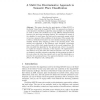Free Online Productivity Tools
i2Speak
i2Symbol
i2OCR
iTex2Img
iWeb2Print
iWeb2Shot
i2Type
iPdf2Split
iPdf2Merge
i2Bopomofo
i2Arabic
i2Style
i2Image
i2PDF
iLatex2Rtf
Sci2ools
CLEF
2010
Springer
2010
Springer
A Multi Cue Discriminative Approach to Semantic Place Classification
This paper describes the participation of Idiap-MULTI to the Robot Vision Task at imageCLEF 2010. Our approach was based on a discriminative classification algorithm using multiple cues. Specifically, we used an SVM and combined up to four different histogram-based features with the kernel averaging method. We considered as output of the classifier, for each frame, the label and its associated margin, which we took as a measure of the confidence of the decision. If the margin value is below a threshold, determined via cross-validation during training, the classifier abstains from assigning a label to the incoming frame. This method was submitted to the obligatory task, obtaining a maximum score of up to 662, which ranked second in the overall competition. We then extended this algorithm for the optional task, where it is possible to exploit the temporal continuity of the sequence. We implemented a door detector so to infer when the robot has entered a new room. Then, we designed a stab...
CLEF 2010 | Discriminative Classification Algorithm | Information Technology | Obligatory Task | Robot Vision Task |
| Added | 08 Nov 2010 |
| Updated | 08 Nov 2010 |
| Type | Conference |
| Year | 2010 |
| Where | CLEF |
| Authors | Marco Fornoni, Jesus Martínez-Gómez, Barbara Caputo |
Comments (0)

